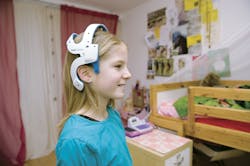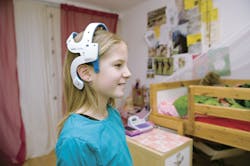Innovations gather and interpret EEG and genetic data
Wearable monitoring devices, cognitive mobile apps, and cloud-based computing are combining to provide consumers with vast quantities of information—and the capability to help them interpret the data. A recently demonstrated medical-data-generating wireless electroencephalography (EEG) headset from imec and Holst Centre supports home EEG monitoring. This device joins prototypes by companies such as members of the Nano-Bio Manufacturing Consortium1 that can measure biomarkers and other factors.
Genetic information, too, is part of the mix, and although it may not be readily available from a wearable device, it can be derived in a relatively simple way by Pathway Genomics, which makes DNA collection kits and provides screening for genetic risk factors. Inc. Magazine named one of the company’s kits as among the 12 coolest products of 2014 manufactured by Inc. 500 companies.2
To help patients interpret the genetic information, IBM Watson Group and Pathway Genomics are leveraging the natural-language processing and cognitive capabilities of a cloud-based implementation of Watson, the computer that won the game show Jeopardy! The companies say consumers will be able to make use of Watson’s cognitive intellect to gain insights and recommendations based on their own genes and data derived from wearables.
Mobile app
In November, the companies announced a mobile app called Pathway Panorama, which, they said, “…will call upon Watson’s unique capability to uncover insights from Big Data by understanding the complexities of human language, referencing millions of pages of healthcare data from medical journals and clinical trial data within seconds.”
The data will be combined with information about the individual’s lifestyle and biomarker data to make personalized recommendations to help the user live a healthier life. Panorama also will routinely monitor a user’s health and wellness information and ping the user with any new relevant recommendations.
For example, a consumer can ask the Pathway Panorama app questions based on her or his DNA, like “How much exercise should I do today?” or “How much coffee can I drink on Monday?” The cognitive app answers and provides guidance based on the healthcare-related evidence-based data ingested by Watson and on the individual’s biomarkers, vital signs, DNA, electronic health records, and other information.
“The medical industry is undergoing a dramatic and systemic change, putting consumers more in charge of their own healthcare. Giving the consumers access to a powerful tool built upon cognitive learning and Watson will make the change even more transformative,” said Michael Nova, M.D., chief medical officer, Pathway Genomics, and a member of the Watson advisory board, in a press release. “Working with the IBM Watson team, we were able to quickly create a working demo of our wellness app with the most powerful cognitive computer in the market today.”
“By tapping into IBM Watson’s cognitive intellect, Pathway Genomics is allowing consumers to ask health- and wellness-related questions in their own words and receive personalized and relevant responses,” added Stephen Gold, vice president, IBM Watson Group. “Cognitive computing solutions based on Watson’s transformative technology will help define how consumers and businesses alike make better informed decisions, delivering better outcomes.”
EEG wearable
As for recent wearable device innovations, imec and Holst Centre have demonstrated their next-generation wireless EEG headset. The headset combines dry electrodes with integrated skin-to-electrode impedance monitoring to provide information about the contact quality throughout the entire EEG recording. Integrated signal processing cancels out motion artifacts. The impedance monitoring and motion artifact cancellation overcome the difficulty of making reliable EEG measurements outside controlled environments.
Within controlled environments, electrode-to-skin impedance is measured before the EEG recording, and the electrodes are carefully adjusted until they all have a proper electrical contact to the skin. During recording, patients are instructed to avoid any kind of motion, especially any that involves head and jaw movements.
In contrast, the imec and Holst Centre wireless EEG headset enables continuous measurement of the electrical impedance between the skin and the electrodes, providing information on the contact quality throughout the entire EEG recording. Moreover, the imec and Holst Centre-developed motion artifact handling approach is based on bandpass and adaptive filtering, which substantially reduces the contamination of the EEG recordings due to motion, and it can operate in real time. These promising results, the organizations say, are a significant step toward the development of wireless EEG systems with dry electrodes that can be used in daily life.
References
- Nelson, R., “NBMC tackles human performance monitoring, medical diagnostics,”EE-Evaluation Engineering, December 2014, p. 23.
- Underwood, R., “The Coolest Products of the Inc. 500,” Inc. Magazine, September 2014.

